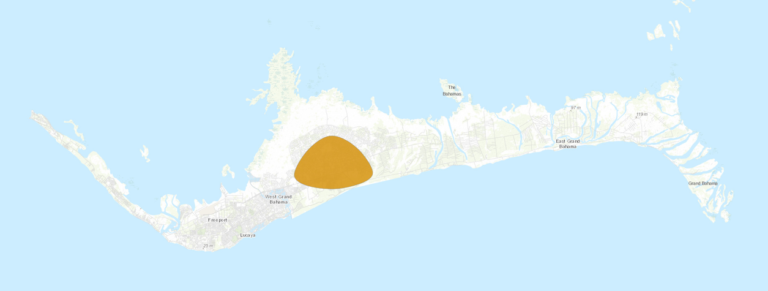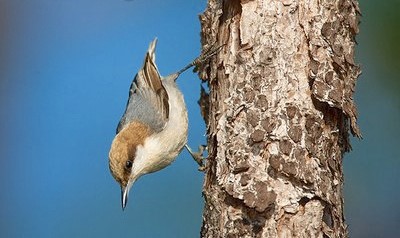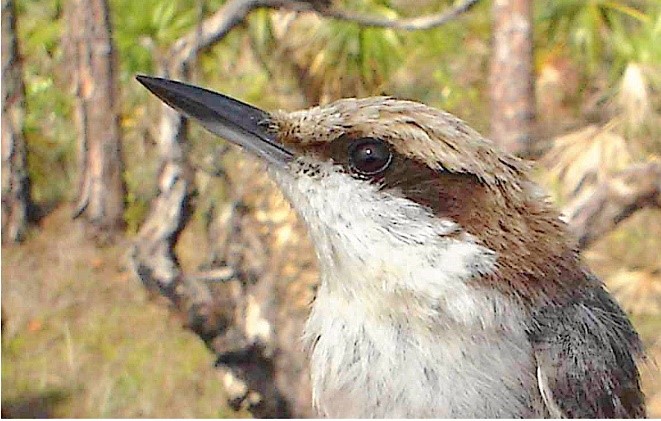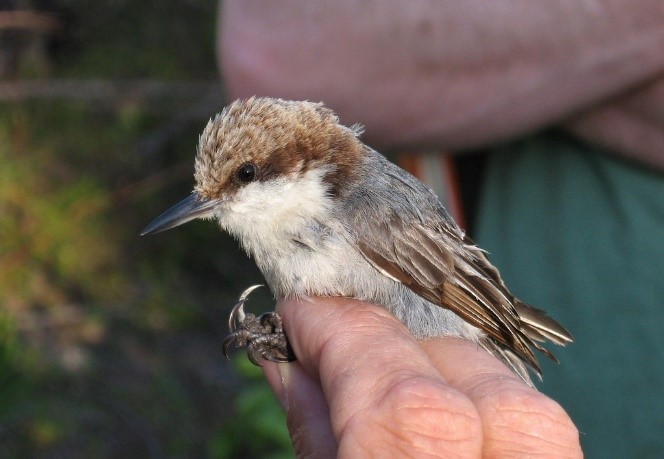Birdfinding.info ⇒ The Bahama Nuthatch is either on or past the brink of extinction. All documented 21st century reports have been from Lucayan Estates and the adjacent Owl’s Hole area in the center-west of Grand Bahama. Surveys in 2018 yielded sightings of approximately three to five individuals. On September 2 and 3, 2019, Hurricane Dorian devastated this area, leaving little room for hope that any representatives of the species survive.
Bahama Nuthatch
Sitta insularis
Family: Sittidae
Endemic to Grand Bahama, where it inhabits (or inhabited) Caribbean Pine forests.


Bahama Nuthatch. © Erika Gates
Identification
Very similar to Brown-headed Nuthatch, but with a somewhat darker eyestripe, longer bill, and different voice.

Bahama Nuthatch. (Lucayan Estates, Grand Bahama; May 30, 2010.) © Bruce Purdy

Bahama Nuthatch, well illuminated. (Owl’s Hole, Grand Bahama; December 27, 2012.) © Bruce Purdy

Bahama Nuthatch, close-up of bird in the hand showing long bill and dark eyestripe. (Lucayan Estates, Grand Bahama; April 20, 2007.) © Gary Slater

Bahama Nuthatch, in the hand during field research. (Lucayan Estates, Grand Bahama; April 20, 2007.) © Tom Benson
Voice. Distinctive call consists of short bursts of soft. high-pitched reverberating notes, often given in series: Macauley Library audio recording from July 26, 2011. © Jeff Gerbracht
Notes
Monotypic species. Traditionally considered a subspecies of Brown-headed Nuthatch, but the recent consensus is that Bahama Nuthatch should be classified as a separate species based on: (1) darker brown facial stripe; (2) much longer bill; (3) shorter wings; and (4) its characteristic call, a rapid high “warble,” unlike the squeaky, rubber-duck calls of the Brown-headed Nuthatch. Genetic analyses indicate that the two forms diverged approximately 685,000 years ago.
IUCN Red List Status: Critically Endangered.
Frontiers in Taxonomy: Bahama Nuthatch Recognized as a Separate Species Shortly Before (Probably) Going Extinct
The devastating severity of Hurricane Dorian’s impact on the Bahama Nuthatch’s entire range in September 2019 was likely fatal to what remained of its precariously small global population. It remains premature to declare the species extinct, but that result had seemed inevitable for several years already.
In his original description of the Bahama Nuthatch in 1931, the ornithologist James Bond designated insularis as a subspecies of Brown-headed (Sitta pusilla), and this presumption remained until the early 2000s. Although it was known to have a different voice, the visual similarity between the two forms had always seemed definitive.
Having been consigned to the rank of a subspecies, its status went largely unmonitored over the decades, and the precise point at which its steep decline began and the causes of that decline are not well understood. It was reportedly common in the 1960s, but considered “very rare” by the 1990s (Raffaele et al. 1998). In 2004, a paper published in the Bahamas Journal of Science took a fresh look at its status and concluded that it should probably be classified as a separate and endangered species (Hayes et al.). By 2016, this proposal had gained wide enough acceptance that BirdLife International announced its intention to reclassify it as such.
In October 2016, Hurricane Matthew hit Grand Bahama, and persistent searches for the Bahama Nuthatch during 2017 were unsuccessful. To all appearances, it had gone extinct just before gaining formal recognition as a species—in effect, while its application for the rank of full species was still pending. But 2018 brought the dramatic headline: “Bird Feared Extinct Rediscovered in the Bahamas.”
In its inaugural Red List status report on the newly recognized species, BirdLife International summarized its population estimate: “In 2018, four days of intensive surveys for the Bahama Nuthatch, covering all sites where the species has been recorded in recent years, failed to find any individuals. Furthermore, once per month for a year, a local bird guide visited one of the main sites where the species was previously recorded, without recording any individuals. In Spring 2018, a further series of surveys recorded a single individual. The small number of recent sightings suggests that the population size of Bahama Nuthatch may now be extremely small.” Later that year, however, researchers disclosed additional 2018 sightings, enough to confirm that at least three and probably a few more Bahama Nuthatches remained alive.
In 2019, as in 2017, searches for the Bahama Nuthatch during the breeding season yielded no detections. Once again, the species was considered likely to have gone extinct, but with the caveat that it had returned from that status once before.
On September 2, 2019, Hurricane Dorian hit Abaco and Grand Bahama as a Category 5 storm, with maximum sustained winds of about 185 miles per hour, and remained centered on Grand Bahama for over 24 hours. The catastrophic storm killed approximately 500 people on Abaco and Grand Bahama, damaged or destroyed most structures on both islands, and permanently altered the lives of those who survived. As a footnote to that overwhelming tragedy, Dorian also snuffed out any lingering hope for the Bahama Nuthatch.
References
BirdLife International. 2018. Sitta insularis. The IUCN Red List of Threatened Species 2018: e.T103881687A131459228. http://dx.doi.org/10.2305/IUCN.UK.2018-2.RLTS.T103881687A131459228.en. (Accessed October 7, 2019.)
BirdsCaribbean. 2018. Bird Feared Extinct Rediscovered in the Bahamas. (Posted August 23, 2018. Accessed October 7, 2019.)
del Hoyo, J., N. Collar, C.J. Sharpe, and J.S. Marks. 2019. Bahama Nuthatch (Sitta insularis). In Handbook of the Birds of the World Alive (J. del Hoyo, A. Elliott, J. Sargatal, D.A. Christie, and E. de Juana, eds.). Lynx Edicions, Barcelona. https://www.hbw.com/node/1343988. (Accessed October 7, 2019.)
eBird. 2019. eBird: An online database of bird distribution and abundance. Cornell Lab of Ornithology, Ithaca, N.Y. http://www.ebird.org. (Accessed October 7, 2019.)
Hayes, W.K., R.X. Barry, Z. McKenzie, and P. Barry. 2004. Grand Bahama’s brown-headed nuthatch: a distinct and endangered species. Bahamas Journal of Science 12:21-28.
Lloyd, J.D., and G.L. Slater. 2011. Abundance and distribution of breeding birds in the pine forests of Grand Bahama, Bahamas. Journal of Caribbean Ornithology 24:1-9.
Raffaele, H., J. Wiley, O. Garrido, A. Keith, and J. Raffaele. 1998. A Guide to the Birds of the West Indies. Princeton University Press, Princeton, N.J.
Rolling Harbour Abaco. 2017. Bahama Nuthatch: Tiny, Rare, a Hop Away from Abaco… https://rollingharbour.com/2017/01/05/bahama-nuthatch-tiny-rare-a-hop-away-from-abaco/. (Posted January 5, 2017. Accessed October 7, 2019.)
Rolling Harbour Abaco. 2018. The Bahama Nuthatch & the Brink of Extinction. https://rollingharbour.com/2018/08/28/the-bahama-nuthatch-the-brink-of-extinction/. (Posted August 28, 2018. Accessed October 7, 2019.)
